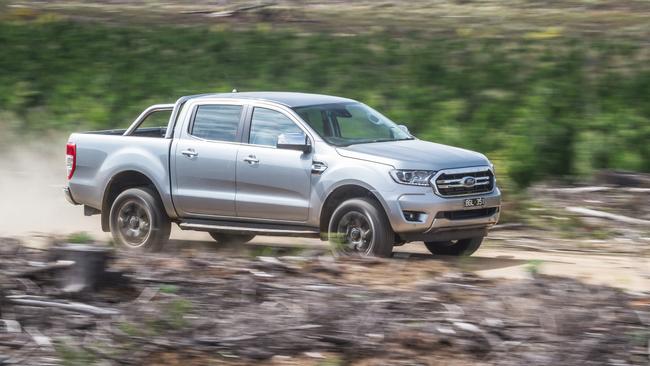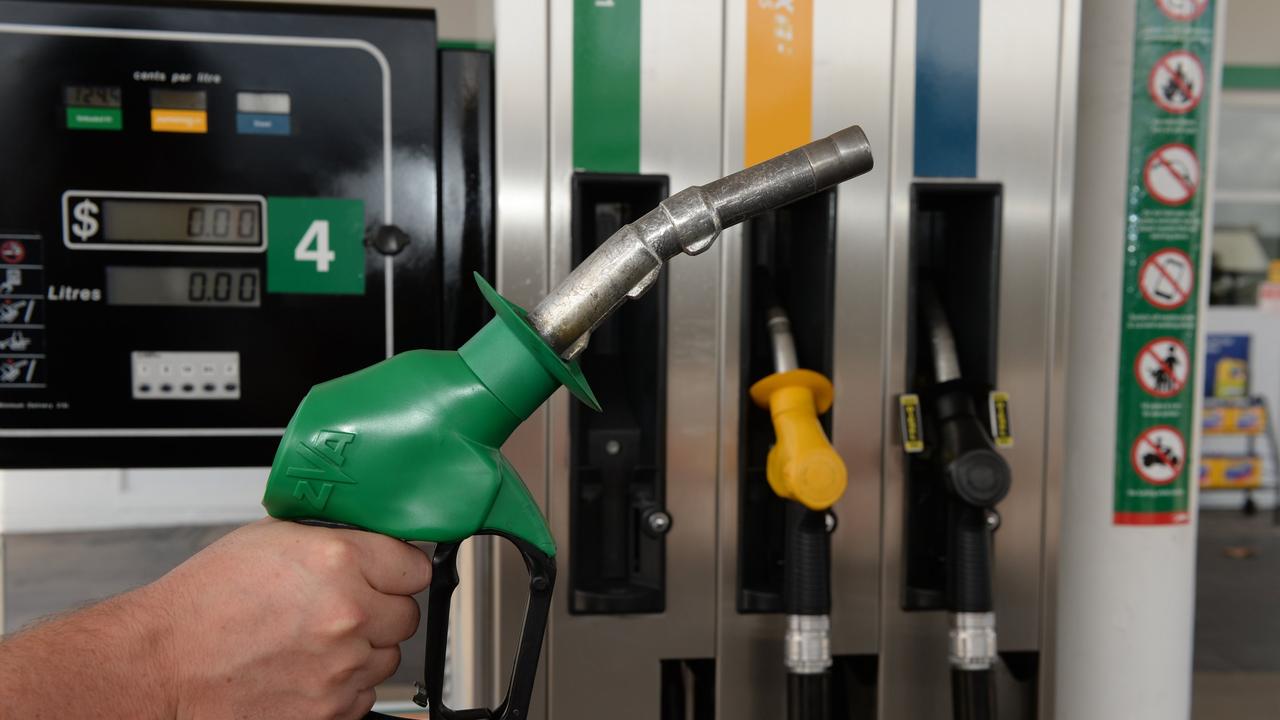Dual-cab ute comparison: Toyota HiLux v Ford Ranger v Isuzu D-Max
The Toyota HiLux is Australia’s best selling ute, the Ford Ranger is the most critically acclaimed, but a new arrival is set to challenge both. See which comes out on top.
car advice
Don't miss out on the headlines from car advice. Followed categories will be added to My News.
Utes have never been bigger business in Australia. In the first half of the year the tradie machines that have morphed into family cars accounted for more than one in five new-vehicle sales.

The action in dealerships has also never been hotter, too, with upgrades to the market-leading Toyota HiLux and the arrival of a new Isuzu D-Max.
We pit the D-Max against the HiLux and the highly regarded Ford Ranger.
FORD RANGER XLT
The Ranger is the oldest here, approaching the twilight of its life but still a sales powerhouse.
Ford’s tweaked and tickled the Ranger, recently adding FordPass allowing an app to unlock or start it remotely.

Behind the wheel it’s a revelation, whether trundling around town or bounding along back roads. Fluid steering and a settled body make it the most comfortable and predictable.
It’s also the quietest, helped by good engine refinement and active noise cancelling that emits opposing frequencies through the speakers.
It helps that the XLT we had used the newer 2.0-litre twin-turbo engine, a $1500 step up over the 3.2-litre. With 157kW and 500Nm it edges the others on performance, helped by a 10-speed auto that shuffles smoothly between gears.

It’s the only one here with stop-start for fuel saving, helping it achieve a 7.4 litres per 100km consumption claim, at least 6 per cent better than its contenders.
Seating is equally inviting, with supportive pews up front and good head and leg room in the rear.
Yet while everything is functional, the cabin is bland compared with the fresher D-Max. Finishes and details are basic rather than wow and it’s the only one here without rear air vents.
Our $65,778 XLT had $750 of wheels, replacing the bland 17-inch wheels with snazzier 18s, the same size as the HiLux and Ranger.
Elsewhere it’s respectably equipped but doesn’t go above and beyond. There’s smart key entry, folding and heated exterior mirrors, a 230V power point in its tray and a trio of USBs, including one in the rear vision mirror.
But there’s no electric seat adjustment, leather trim or active cruise control.

ISUZU D-MAX X-TERRAIN
Drive-away deals means the new D-Max has the sharpest price, even in top X-Terrain trim. It’s about 10 per cent cheaper and servicing is good value, sneaking in under $2000 for five years.
At $58,990 it’s also generously appointed with leather, smart key and a 9.0-inch touchscreen, an inch bigger than the rivals. It’s the only one with blind-spot warning, part of a class-leading safety armoury that also includes active cruise control, a centre front airbag, auto braking and rear cross traffic alert.

While all three have Apple CarPlay and Android Auto, in the Isuzu it’s wireless.
The standard roller cover keeps things in the tray secure, although deletes two of the four tie-downs.
The D-Max also gets an extra year of warranty — six in total — albeit with a 150,000km limit.
One omissions is a towbar (standard on rivals), costing about $1300. The spare tyre is full-sized, but fitted to a steel rim.
The infotainment system requires familiarisation and lacks easy volume adjustment with buttons instead of a dial.

Despite the “new” tag there’s familiarity elsewhere.
The truck-derived 3.0-litre turbo diesel has been polished but is vocal, with a boisterous clatter once the turbo chimes in. With 140kW it’s outclassed here, although the easy accessibility of its 450Nm of torque ensures stout acceleration.
Less endearing is the six-speed auto, which gives a mild jolt as it shuffles from sixth to fifth when cruising.
Steering is light, too much so at speed, where it feels dead on-centre and doesn’t inspire confidence elsewhere. It’s a slow ratio, too, so more input is required.
Suspension is jiggly unladen at city speeds but settles into a more cosseting groove above 60km/h.
TOYOTA HILUX SR5
A fresh face and updated engine are the highlights for the updated HiLux. Engineers have again attacked the suspension in an effort to quell its fidgety rear end.
The return of dials and buttons to audio functions and the addition of Apple CarPlay and Android Auto is equally significant, simplifying the infotainment.

Plenty of the old car remains, though, including a functional but unexciting cabin.
HiLux retains its price premium and the popular SR5 tested here is now about $65,000 as an auto. With services required every six months, it’s the most expensive to maintain, costing $500 a year for the first three years before spiking in years four and five.
Want leather and electric seat adjustment? It’s part of a $2500 “+” pack that still doesn’t include separate ventilation controls for driver and passenger.

A bare metal tray demonstrates more penny pinching and it lacks rear cross-traffic alert and blind-spot alert.
Auto emergency braking, active cruise and speed-sign recognition match the others here.
HiLux downsides remain. It’s cabin is a smidgen narrower than rivals and rear head and knee space are less generous.
The engine finally has the muscle it should have, though. Power is boosted to 150kW and torque to 500Nm. There’s plenty of the old engine’s character, but more fire in the upper half of the rev range for swifter overtaking or hill climbing.
Revised steering is relatively heavy in three-point turns, but at speed the additional meat adds assurance.
The ride is still firm, though, and wind and road noise a whisker above rivals.
Arguably the HiLux’s biggest asset is how it’s likely to treat you over time. Superb resale credentials mean its price premium should pay itself back.

VERDICT
The HiLux’s lean spread of equipment and compromised cabin leave it at the tail.
Despite its age, the Ranger delivers the most driving sophistication, although the Isuzu has closed the gap on road.
Add to that sharper pricing, a more modern interior and more safety gear and the D-Max edges in front.

ISUZU D-MAX X-TERRAIN VITALS
Price: About $58,990 drive-away
Warranty/servicing: 6 yrs/150,000km, $1995 for 5 years/75,000km
Safety: Five stars (2020), 8 airbags, blind-spot warning, auto emergency braking, traffic sign recognition, rear traffic alert, lane-keep assist
Engine: 3.0-litre 4-cyl turbo diesel, 140kW/450Nm
Thirst: 8.0L/100km
Tow capacity/payload at max tow capacity: 3500kg/320kg
Spare: Full size
FORD RANGER XLT VITALS
Price: About $65,778 drive-away
Warranty/servicing: 5 years/u’ltd km, $2490 for 5 years/75,000km
Safety: 5-star (2015), 6 airbags, auto emergency braking, traffic-sign recognition, rear cross-traffic alert, lane-keep assist
Engine: 2.0-litre 4-cyl twin-turbo diesel, 157kW/500Nm
Thirst: 7.4L/100km
Tow capacity/payload at max tow capacity: 3500kg/303kg
Spare: Full size
TOYOTA HILUX SR5 VITALS
Price: About $65,386 drive-away
Warranty/servicing: 5 years/unlimited km, $3539 for 5 years/100,000km
Safety: 5-star (2019), 7 airbags, auto emergency braking, traffic sign recognition, lane-keep assist
Engine: 2.8-litre 4-cyl turbo diesel, 150kW/500Nm
Thirst: 7.9L/100km
Tow capacity/payload at max tow capacity: 3500kg/300kg
Spare: Full size
Originally published as Dual-cab ute comparison: Toyota HiLux v Ford Ranger v Isuzu D-Max


